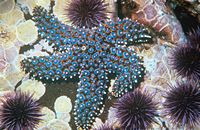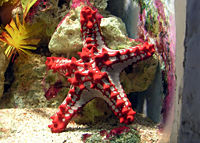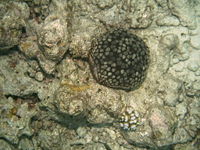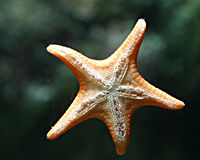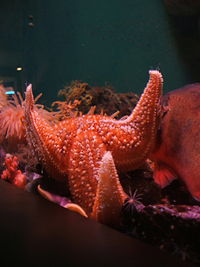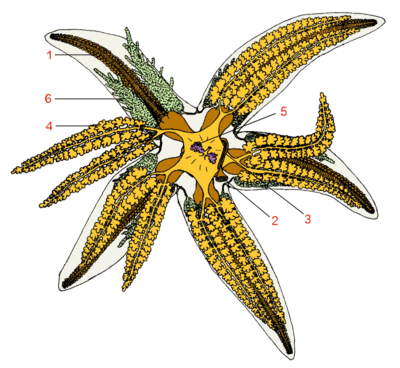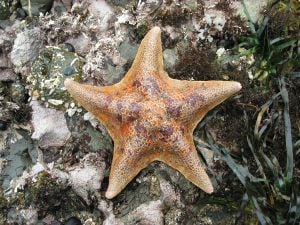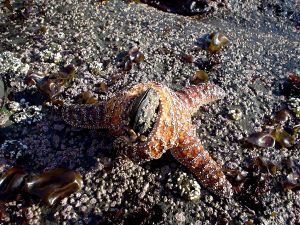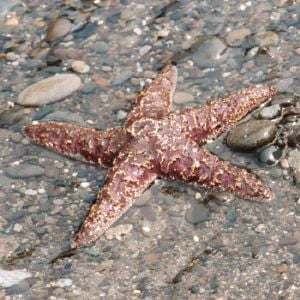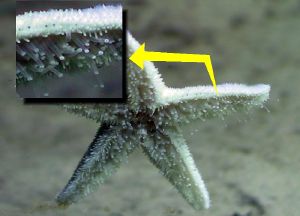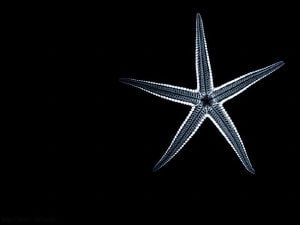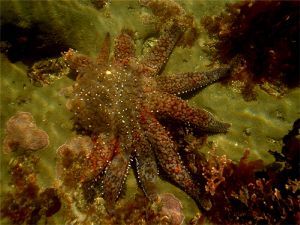Difference between revisions of "Starfish" - New World Encyclopedia
David Doose (talk | contribs) (added hemal system section) |
David Doose (talk | contribs) (edited nervous system) |
||
| Line 21: | Line 21: | ||
}} | }} | ||
| − | '''Starfish''' (more correctly known as '''''sea stars''''' | + | '''Starfish''' (more correctly known as '''''sea stars''''' since they are very distantly related to fish), are marine invertebrates belonging to the kingdom [[animalia]], phylum [[Echinoderm]]ata, and class '''Asteroidea''', of which there are over 1800 known species. The names sea star and starfish are also (incorrectly) used for the closely related brittle stars, which make up the class Ophiuroidea. Characteristics of sea stars include that they exhibit a superficially [[symmetry (biology)#Radial symmetry|radial symmetry]], since they typically have five or more "arms" which radiate from an indistinct disk ([[symmetry (biology)#Pentamerism|pentaradial symmetry]]), and tend to be covered in spines. |
| − | + | Like other echinoderms, starfish possess an endoskeleton, but do not rely on it for support and locomotion, instead using a hydraulic water vascular system that functions via many projections called tube feet, located on the ventral surface of the starfish's arms. A sea star's diet includes mollusks and other marine organisms, and they are able to evert their stomach in order to pull apart and digest their shelled prey. While starfish can reproduce sexually, if an arm of the starfish is severed from the body and it contains a portion of the central nerve ring, then another starfish can regrows from the severed portion, which makes starfish pests to commercial clam and oyster beds. | |
==Distribution== | ==Distribution== | ||
| Line 45: | Line 45: | ||
===Digestion and excretion=== | ===Digestion and excretion=== | ||
| − | Starfish digestion is carried out in two separate [[stomach]]s | + | Starfish digestion is carried out in two separate [[stomach]]s, the cardiac stomach and the pyloric stomach. The cardiac stomach, which is a sack-like stomach located at the center of the body, may be everted, or pushed out of the organism's body, and used to engulf and digest food. Some species take advantage of the great endurance of their water vascular systems to force open the shells of [[bivalve]] [[mollusk]]s such as clams and [[mussel]]s, and inject their stomachs into the shells. Once the stomach is inserted inside the shell it digests the mollusk in place. The cardiac stomach is then brought back inside the body, and the partially digested food is moved to the pyloric stomach. Further digestion occurs in the intestine and waste is excreted through the anus on the aboral side of the body. |
| − | Because of this ability to digest food outside of its body, the sea star is able to hunt prey that are much larger than its mouth would otherwise allow including [[arthropod]]s, and even small [[fish]] in addition to mollusks. | + | Because of this ability to digest food outside of its body, the sea star is able to hunt prey that are much larger than its mouth would otherwise allow including [[arthropod]]s, and even small [[fish]], in addition to mollusks. |
Some echinoderms have been shown to live for several weeks without food under artificial conditions—it is believed that they may receive some nutrients from organic material dissolved in seawater. | Some echinoderms have been shown to live for several weeks without food under artificial conditions—it is believed that they may receive some nutrients from organic material dissolved in seawater. | ||
| − | Sea stars and other echinoderms have endoskeletons (internal skeletons), which is one of the reasons some scientists are led to believe that echinoderms are very closely related to chordates (animals with a hollow nerve chord that usually have vertebrae). | + | ===Skeletal system=== |
| − | + | Sea stars and other echinoderms have endoskeletons (internal skeletons) that are composed of calcium carbonate plates called ossicles, which is one of the reasons some scientists are led to believe that echinoderms are very closely related to chordates (animals with a hollow nerve chord that usually have vertebrae). | |
| − | |||
| − | |||
| − | |||
| − | |||
| − | |||
| − | |||
| − | |||
| − | |||
| − | |||
===Nervous system=== | ===Nervous system=== | ||
[[Image:Star Fish at Montana de Oro.JPG|thumb|Bat star, ''Asterina miniata'']] | [[Image:Star Fish at Montana de Oro.JPG|thumb|Bat star, ''Asterina miniata'']] | ||
| − | + | Starfish have a simple nervous system that lacks a true brain, and consists partially of a nerve plexus (a network of interlacing nerves), which lies within as well as below the skin. The esophagus is also surrounded by a number of nerve rings, which send radial nerves that are often parallel with the branches of the water vascular system. The ring nerves and radial nerves coordinate the starfish's balance and directional systems. Although echinoderms do not have many well-defined sensory inputs, they are sensitive to touch, light, temperature, orientation, and the status of water around them. The tube feet, spines, and pedicellariae found on starfish are sensitive to touch, while eyespots on the ends of the rays are light-sensitive. | |
==Behavior== | ==Behavior== | ||
| Line 93: | Line 84: | ||
Fossil starfish and brittle stars are first known from rocks of [[Ordovician]] age indicating that two groups probably diverged in the [[Cambrian]]. However, Ordovician examples of the two groups show many similarities and can be difficult to distinguish. Complete fossil starfish are very rare, but where they do occur they may be abundant. Most fossil starfish consist of scattered individual plates or segments of arms. This is because the skeleton is not rigid, as in the case of echinoids (sea urchins), but is composed of many small plates (or ossicles) which quickly fall apart and are scattered after death and the decay of the soft parts of the creature. Scattered starfish ossicles are reasonably common in the [[Cretaceous]] [[Chalk]] Formation of [[England]]. | Fossil starfish and brittle stars are first known from rocks of [[Ordovician]] age indicating that two groups probably diverged in the [[Cambrian]]. However, Ordovician examples of the two groups show many similarities and can be difficult to distinguish. Complete fossil starfish are very rare, but where they do occur they may be abundant. Most fossil starfish consist of scattered individual plates or segments of arms. This is because the skeleton is not rigid, as in the case of echinoids (sea urchins), but is composed of many small plates (or ossicles) which quickly fall apart and are scattered after death and the decay of the soft parts of the creature. Scattered starfish ossicles are reasonably common in the [[Cretaceous]] [[Chalk]] Formation of [[England]]. | ||
| − | == | + | ==Variety== |
| − | * | + | Here is a small sampling of the various types of starfish: |
| − | * | + | *Blue sea star |
| − | * | + | *Japanese sea star |
| − | * | + | *Carpet sea star |
| − | * | + | *Eleven-armed sea star |
| − | * | + | *Pincushion sea star |
| + | *Comb sea star | ||
| + | *Crown of thorns sea star | ||
==References== | ==References== | ||
Revision as of 20:32, 21 August 2007
| Starfish | ||||||||
|---|---|---|---|---|---|---|---|---|
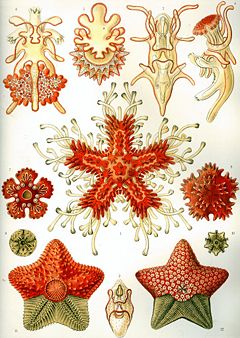 "Asteroidea" from Ernst Haeckel's Kunstformen der Natur, 1904
| ||||||||
| Scientific classification | ||||||||
| ||||||||
|
Brisingida (100 species[1]) |
Starfish (more correctly known as sea stars since they are very distantly related to fish), are marine invertebrates belonging to the kingdom animalia, phylum Echinodermata, and class Asteroidea, of which there are over 1800 known species. The names sea star and starfish are also (incorrectly) used for the closely related brittle stars, which make up the class Ophiuroidea. Characteristics of sea stars include that they exhibit a superficially radial symmetry, since they typically have five or more "arms" which radiate from an indistinct disk (pentaradial symmetry), and tend to be covered in spines. Like other echinoderms, starfish possess an endoskeleton, but do not rely on it for support and locomotion, instead using a hydraulic water vascular system that functions via many projections called tube feet, located on the ventral surface of the starfish's arms. A sea star's diet includes mollusks and other marine organisms, and they are able to evert their stomach in order to pull apart and digest their shelled prey. While starfish can reproduce sexually, if an arm of the starfish is severed from the body and it contains a portion of the central nerve ring, then another starfish can regrows from the severed portion, which makes starfish pests to commercial clam and oyster beds.
Distribution
There are about 1,800 known living species of starfish, and and they occur in all of the Earth's oceans (though the greatest variety of starfish is found in the tropical Indo-Pacific). Habitats range from tropical coral reefs to kelp forests to the deep-sea floor, although none live within the water column; all species of starfish found are living as benthos (or on the ocean floor). Because echinoderms need to maintain a delicate internal balance in their body, no starfish are found in freshwater environments.
External anatomy
Starfish are composed of a central disc from which arms (usually five, but the number can vary) sprout in pentaradial symmetry. The mouth is located underneath the starfish on the oral or ventral surface, while the anus is located on the top of the animal. The spiny upper surface covering the species is called the aboral (meaning the side opposite to the mouth) or dorsal surface. On this surface there is a structure called the madreporite (or the sieve plate), a small white spot located slightly off-center on the central disc which acts as a water filter and supplies the starfish's water vascular system with water to move. Also on the aboral surface, surrounding the spines, are small white objects known as pedicellarieae, which are like pairs of claws or jaws that serve to prevent encrusting organisms from colonizing the starfish. The radial canals (a part of the internal anatomy), which extend from the center of the starfish out towards the tips of the arms, have hollow, muscular tube feet branching from them. Each tube foot has a bulb-like ampulla, as well as a suckered podium (or foot part), which are a part of the water vascular system. Starfish also have a simple photoreceptor eyespot at the end of each arm that is able to "see" differences of light and dark, enabling the starfish to detect movement. Additional parts like cribriform organs present exclusively in Porcellanasteridae are used to generate current in the burrows made by these infaunal starfish.
While starfish generally adhere to this basic body plan, there is great variety in the shape (ranging from nearly pentagonal like the Indo-pacific cushion star, Culcita novaeguineae, to gracile stars like those of the Zoroaster genus), the color, and the morphology between each species. Some species have patterns that serve as camouflage or warning coloration, which include mosaic-like tiles formed by ossicles, stripes, interconnecting net between spines, and pustules with bright colors, mottles or spots.
Internal anatomy
Hemal system
Echinoderms have a simple circulatory system (also called a hemal system) that is linked with their excretory system. In the starfish, the hemal system is used to distribute nutrients, with hemal channels forming rings around the mouth (the oral hemal ring), closer to the top of the starfish, and around the digestive system (the gastric hemal ring). The axial sinus, a portion of the body cavity, connects the three rings. Each ray of the starfish also has hemal channels running next to the gonads.
Digestion and excretion
Starfish digestion is carried out in two separate stomachs, the cardiac stomach and the pyloric stomach. The cardiac stomach, which is a sack-like stomach located at the center of the body, may be everted, or pushed out of the organism's body, and used to engulf and digest food. Some species take advantage of the great endurance of their water vascular systems to force open the shells of bivalve mollusks such as clams and mussels, and inject their stomachs into the shells. Once the stomach is inserted inside the shell it digests the mollusk in place. The cardiac stomach is then brought back inside the body, and the partially digested food is moved to the pyloric stomach. Further digestion occurs in the intestine and waste is excreted through the anus on the aboral side of the body.
Because of this ability to digest food outside of its body, the sea star is able to hunt prey that are much larger than its mouth would otherwise allow including arthropods, and even small fish, in addition to mollusks.
Some echinoderms have been shown to live for several weeks without food under artificial conditions—it is believed that they may receive some nutrients from organic material dissolved in seawater.
Skeletal system
Sea stars and other echinoderms have endoskeletons (internal skeletons) that are composed of calcium carbonate plates called ossicles, which is one of the reasons some scientists are led to believe that echinoderms are very closely related to chordates (animals with a hollow nerve chord that usually have vertebrae).
Nervous system
Starfish have a simple nervous system that lacks a true brain, and consists partially of a nerve plexus (a network of interlacing nerves), which lies within as well as below the skin. The esophagus is also surrounded by a number of nerve rings, which send radial nerves that are often parallel with the branches of the water vascular system. The ring nerves and radial nerves coordinate the starfish's balance and directional systems. Although echinoderms do not have many well-defined sensory inputs, they are sensitive to touch, light, temperature, orientation, and the status of water around them. The tube feet, spines, and pedicellariae found on starfish are sensitive to touch, while eyespots on the ends of the rays are light-sensitive.
Behavior
Diet
Most species are generalist predators, some eating bivalves like mussels, clams, and oysters; or any animal too slow to evade the attack (e.g. dying fish). Some species are detritivores, eating decomposed animal and plant material, or organic films attached to substrate. The others may consume coral polyps (the best-known example for this is the infamous Acanthaster planci), sponges or even suspended particles and plankton (starfish from the Order Brisingida). The process of feeding or capture may or may not be aided by special parts; Pisaster brevispinus or Short-spined Pisaster from the west coast of America may use a set of specialized tube feet capable of extending itself deep into the soft substrata, hauling out the prey (usually clams) from within[2]. Grasping the shellfish, the Starfish is able to slowly pry open the shell by wearing out the Adductor muscle and then by inserting an arm into an opening, devour the organism.
Reproduction
Starfish are capable of both sexual and asexual reproduction. Individual starfish are male or female. Fertilization takes place externally, both male and female releasing their gametes into the environment. Resulting fertilized embryos form part of the zooplankton.
Starfish are developmentally (embryologically) known as deuterostomes. Their embryo initially develops bilateral symmetry, indicating that starfish probably share a common ancestor with the chordates, which includes the fish. Later development takes a very different path however as the developing starfish settles out of the zooplankton and develops the characteristic radial symmetry. Some species reproduce cooperatively, using environmental signals to coordinate the timing of gamete release; in other species, one to one pairing is the norm.
Some species of starfish also reproduce asexually by fragmentation, often with part of an arm becoming detached and eventually developing into an independent individual starfish. This has led to some notoriety. Starfish can be pests to fishermen who make their living on the capture of clams and other mollusks at sea as starfish prey on these. The fishermen would presumably kill the starfish by chopping them up and disposing of them at sea, ultimately leading to their increased numbers until the issue was better understood. A starfish arm can only regenerate into a whole new organism if some of the central ring of the starfish is part of the chopped off arm.
Locomotion
Starfish move using a water vascular system. Water comes into the system via the madreporite. It is then circulated from the stone canal to the ring canal and into the radial canals. The radial canals carry water to the ampullae and provide suction to the tube feet. The tube feet latch on to surfaces and move in a wave, with one body section attaching to the surfaces as another releases. Most starfish cannot move quickly. However, some burrowing species like starfish from genus Astropecten and Luidia are quite capable of rapid, creeping motion - it "glides" across the ocean floor. This motion results from their pointed tubefeet adapted specially for excavating local area of sand.
Regeneration
Some species of starfish have the ability to regenerate lost arms and can regrow an entire new arm in time. Most species must have the central part of the body intact to be able to regenerate, but a few can grow an entire starfish from a single ray. Included in this group are the red and blue Linckia star. The regeneration of these stars is possible due to the vital organs kept in their arms.
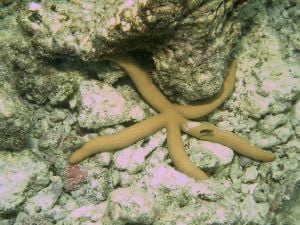
Geological history
Fossil starfish and brittle stars are first known from rocks of Ordovician age indicating that two groups probably diverged in the Cambrian. However, Ordovician examples of the two groups show many similarities and can be difficult to distinguish. Complete fossil starfish are very rare, but where they do occur they may be abundant. Most fossil starfish consist of scattered individual plates or segments of arms. This is because the skeleton is not rigid, as in the case of echinoids (sea urchins), but is composed of many small plates (or ossicles) which quickly fall apart and are scattered after death and the decay of the soft parts of the creature. Scattered starfish ossicles are reasonably common in the Cretaceous Chalk Formation of England.
Variety
Here is a small sampling of the various types of starfish:
- Blue sea star
- Japanese sea star
- Carpet sea star
- Eleven-armed sea star
- Pincushion sea star
- Comb sea star
- Crown of thorns sea star
ReferencesISBN links support NWE through referral fees
- Blake DB, Guensburg TE; Implications of a new early Ordovician asteroid (Echinodermata) for the phylogeny of Asterozoans; Journal of Paleontology, 79 (2): 395-399; MAR 2005.
- Gilbertson, Lance; Zoology Lab Manual; McGraw Hill Companies, New York; ISBN 0-07-237716-X (fourth edition, 1999).
- Shackleton, Juliette D.; Skeletal homologies, phylogeny and classification of the earliest asterozoan echinoderms; Journal of Systematic Palaeontology; volume 3 (issue 1):pages 29-114; March 2005.
- Solomon, E.P., Berg, L.R., Martin, D.W. 2002. Biology, Sixth Edition. ISBN: 0534391753.
- Sutton MD, Briggs DEG, Siveter David J, Siveter Derek J, Gladwell DJ; A starfish with three-dimensionally preserved soft parts from the Silurian of England; Proceedings of the Royal Society, London B - Biological Sciences; 272 (1567): 1001-1006; MAY 22 2005.
- Hickman C.P, Roberts L.S, Larson A., l'Anson H., Eisenhour D.J.; Integrated Principles of Zoology; McGraw Hill; New York; ISBN 0-07-111593-5 (Thirteenth edition; 2006).
Resources
- Starfish Science
- From the Tree of Life project
- Classification of the Extant Echinodermata
- Starfish Home Page
- Starfish Population Explosion
- Beautiful story - The Legend of the Starfish
Credits
New World Encyclopedia writers and editors rewrote and completed the Wikipedia article in accordance with New World Encyclopedia standards. This article abides by terms of the Creative Commons CC-by-sa 3.0 License (CC-by-sa), which may be used and disseminated with proper attribution. Credit is due under the terms of this license that can reference both the New World Encyclopedia contributors and the selfless volunteer contributors of the Wikimedia Foundation. To cite this article click here for a list of acceptable citing formats.The history of earlier contributions by wikipedians is accessible to researchers here:
The history of this article since it was imported to New World Encyclopedia:
Note: Some restrictions may apply to use of individual images which are separately licensed.
